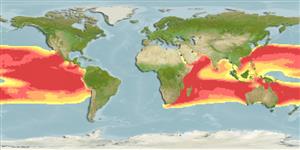Actinopterygii (ray-finned fishes) >
Perciformes (Perch-likes) >
Istiophoridae (Billfishes)
Etymology: Istiophorus: Greek, istios = sail + Greek, pherein = to carry (Ref. 45335).
Environment / Climate / Range
Ecology
Marine; pelagic-oceanic; oceanodromous (Ref. 51243); depth range 0 - 200 m (Ref. 54238), usually 30 - ? m (Ref. 9688). Subtropical, preferred 28°C (Ref. 107945); 50°N - 43°S, 16°E - 71°W (Ref. 43)
Indo-Pacific: tropical and temperate waters approximately 45°- 50°N and 40°-35°S in the western Pacific, 35°N and 35°S in the eastern Pacific; 45°S in western Indian Ocean and 35°S in eastern Indian Ocean. Entered Mediterranean Sea from Red sea via Suez Canal. Highly migratory species, Annex I of the 1982 Convention on the Law of the Sea (Ref. 26139). Some authors recognize a single worldwide species, Istiophorus platypterus (Shaw & Nodder 1792) but we follow Nakamura 1990 (Ref. 10820) retaining the usage of Istiophorus platypterus for the Indo-Pacific sailfish and Istiophorus albicans for the Atlantic sailfish in recognition of the differences between them.
Size / Weight / Age
Maturity: Lm ? range ? - 150 cm
Max length : 348 cm FL male/unsexed; (Ref. 40637); common length : 270 cm TL male/unsexed; (Ref. 9308); max. published weight: 100.2 kg (Ref. 40637); max. reported age: 13 years (Ref. 53742)
Dorsal
spines
(total): 0;
Dorsal
soft rays
(total): 47-53;
Anal
spines: 2;
Anal
soft rays: 12 - 15. Body elongate and compressed; upper jaw prolonged into a very long beak; two dorsal fins, the first very large and tail; pelvic fins narrow but very long, almost reaching anus, with 1 spine and 2 rays; body covered with small, embedded scales with 1 or 2 blunt points; back dark with about 20 bluish vertical bars; belly pale silver; membrane of first dorsal fin blue black with numerous dark spots (Ref. 55763). A slender billfish with a high, sail-like first dorsal fin (Ref. 26938).
Oceanic and epipelagic species usually found above the thermocline. Most densely distributed in waters close to coasts and islands (Ref. 9688). Most likely schools by size. Undergoes spawning migrations in the Pacific (Ref. 43). Feeds mainly on fishes, crustaceans and cephalopods. Utilized fresh, smoked and frozen; also used for sashimi and sushi; eaten broiled and baked (Ref. 9987).
Seems to spawn throughout the year in tropical and subtropical waters of the Pacific with peak spawning occurring in the respective local summer seasons. Spawning occurs with males and females swimming in pairs or with two or three males chasing a single female (probably a mating behavior). The ripe ovarian eggs are about 0.85 mm in diameter and have a single oil globule; there are no structures on the vitalize membrane and the egg is transparent. Eggs shed from captured female in the Indian Ocean averaged 1.304 mm in diameter.
Nakamura, I., 1985. FAO species catalogue. Vol. 5. Billfishes of the world. An annotated and illustrated catalogue of marlins, sailfishes, spearfishes and swordfishes known to date. FAO Fish. Synop. 125(5):65p. Rome: FAO. (Ref. 43)
IUCN Red List Status (Ref. 115185)
CITES (Ref. 94142)
Not Evaluated
Threat to humans
Harmless
Human uses
Fisheries: commercial; gamefish: yes
More information
ReferencesAquacultureAquaculture profileStrainsGeneticsAllele frequenciesHeritabilityDiseasesProcessingMass conversion
Tools
Special reports
Download XML
Internet sources
